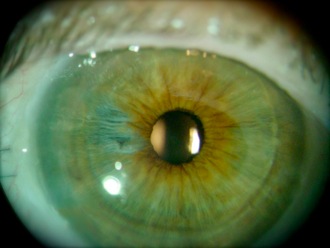Sutureless Cornea Transplant
DSAEK (Descemet’s stripping automated endothelial keratoplasty)
When the inner cell layer of the cornea endothelium) stops working, the cornea becomes cloudy. This has traditionally been treated by replacing the entire cornea with a full-thickness donated transplant. Recently, a new cornea transplant technique has evolved which replaces only the damaged inner cell layer instead of replacing the entire thickness of the cornea. With this new technique, known as Descemet’s Stripping with Automated Endothelial Keratoplasty (DSAEK), the cornea heals much faster and stronger and the patient’s visual recovery is better.
Because this technique leaves a smoother interface and significantly better the visual results, it has become our preferred method of treatment for Fuchs' Dystrophy and pseudophakic bullous keratopathy. Many posterior graft patients now routinely see 20/60 or better within 3 months of surgery and some 20/20.
DSEK surgery is performed by harvesting the back 10-20% of the donor cornea (contains the endothelial cells whose job is to pump fluid from the cornea) with an automated microkeratome. It is then folded over like a taco and placed into the eye through a 5mm scleral tunnel incision. An air bubble is injected (see figure) to push the donor tissue up against the back surface of the patient's cornea. The natural pumping action of the endothelial cells quickly creates suction, which bonds the donor tissue to the recipient cornea. After a few weeks, the endothelial pump clears the cloudy cornea.

Advantages of DSEK as compared to full thickness transplantation (PKP) are:
• The eye is left much stronger and more resistant to injury
• There is minimal change in glasses strength because the patient's cornea is essentially intact
• Suture-related problems can be eliminated
• Visual recovery is significantly faster and better
DSAEK offers patients better visual recovery and shorter visual recovery than standard PKP. It is a great alternative for younger, more active patients bothered by glare and blurring from guttata or for the elderly who dread the long and involved postoperative course of standard PKP.
Corneal Transplantation (penetrating keratoplasty)
Full thickness corneal transplantation (PKP) involves replacing the entire cornea, from front to back, with a donated cornea (see figure). This technique is necessary when there is damage to endothelium and overlying tissue called stroma.
pastedGraphic
Lamellar Keratoplasty (LK)
This involves replacing the middle (stroma) and front layer of the cornea, with a donated cornea. This technique is necessary when damage is limited to the stromal layer of the cornea (see figure). Because no endothelium is transplanted, these grafts have virtually no chance of rejecting.
pastedGraphic
Other cornea procedures
Amniotic Membrane grafting, Corneal stem cell transplantation, Pterygium surgery, and more.
